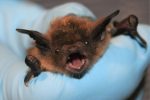
It has finally begun to feel like spring where I live, even though it was snowing this morning when I arose. The trees are not leafing yet, but the maples are budding, and animal life is conspicuous. In the past week, I have seen or heard the Barred Owl, Short-eared Owl, Cooper’s Hawk, Broad-winged Hawk, Osprey, Pileated Woodpecker, and the drumming wing feathers of the courting Ruffed Grouse.
One particularly welcome sight was a Little Brown Bat that sailed by my left shoulder on a dirt road near the village. I haven’t seen spring daytime bats in years. When the Little Brown Bat emerges from hibernation, she hunts during the day for insects which are inactive at night in cool weather. I used to see groups of bats flittering in the midday sun in early spring, but that changed years ago. White-nose Syndrome was first discovered in upstate New York in 2007 and has since spread throughout North America. A few species are predicted to become extinct, though the Little Brown Bat has a chance since her numbers were so high and her colonies so widespread to begin with.

I hoped that this was a sign that the disease has run its course and the Little Brown Bat is recovering, but my Internet search only revealed that White-nose is spreading to places far from the original sighting, like southern Texas. Still, I might be one of the first to notice signs of recovery, if that is occurring. “One swallow does not a summer make,” and one bat is not a colony, but I am hopeful.
